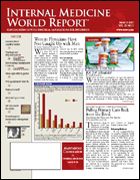Adding a PPI to a Nonselective NSAID Provides Gastric Protection
Adding a PPI to a Nonselective NSAID Provides Gastric Protection
By Wayne Kuznar
With an FDA advisory panel convinced that the cyclooxygenase (COX)-2 inhibitors, which are selective nonsteroidal anti-inflammatory drugs (NSAID), increase cardiovascular (CV) risk, physicians and patients will be looking for alternatives for relief of chronic pain and inflammation while maximizing CV and gastrointestinal (GI) safety.
Data suggest that the use of a nonselective NSAID combined with a proton pump inhibitor (PPI) affords upper GI protection similar to that achieved with a COX-2 inhibitor, according to Byron Cryer, MD, of the Division of Gastroenterology, University of Texas Southwestern Medical School, Dallas.
The COX-2 inhibitors were originally conceived as an alternative to traditional NSAIDs, and were widely accepted as a positive alternative especially since they appeared to lack the GI toxicity usually associated with the nonselective agents. Most of the GI superiority attributed to the COX-2 inhibitors was based on data of rofecoxib (Vioxx) compared with naproxen (eg, Aleve, Anaprox), but the same studies showed an increase in serious thrombotic CV events with rofecoxib in the comparison.
After the pivotal trial VIGOR (VIOXX GI Outcomes Research), rofecoxib was thought to reduce clinically significant upper GI events by about 50% compared with the nonselective NSAIDs, but the actual reduction in serious upper GI events “is probably closer to 30%,” said Dr Cryer, an FDA consultant who spoke at the FDA advisory committee hearings. The specific reduction in risk depends on the NSAID comparator, he added.
Indeed, postmarketing data prompted Maria Lourdes Villalba, MD, a medical officer in the division of anti-inflammatory, analgesic, and ophthalmologic drug products at the FDA, to issue the following statement following the drug’s approval: “Despite a substantial risk reduction compared with naproxen in the VIGOR study, the risk of serious GI complications associated with rofecoxib is still a concern.”
In fact, studies show that the GI benefit of COX-2 inhibitors is lost when aspirin is given concomitantly, which may be the case in patients using chronic aspirin for CV protection.
The question becomes, said Dr Cryer, “how can we continue to provide anti-inflammatory action while reducing the risk from GI toxicity when we are providing cardioprotection?” He noted that the traditional nonselective NSAIDs provide equivalent analgesia and have similar anti-inflammatory properties as the COX-2 inhibitors.
Some of the nonspecific NSAIDs that are relatively safer in terms of GI toxicity are nabumetone (Relafen), diclofenac (Cataflam), and etodolac (Lodine), but observational data presented at the recent FDA advisory committee meeting showed that these same NSAIDs may be riskier than other nonspecific NSAIDs in promoting CV harm.
A strategy that is often overlooked is the use of an NSAID with a PPI, said Dr Cryer. This strategy is as effective as a COX-2 inhibitor in protecting against upper GI events, which account for 85% of the total number of hospitalizations from GI bleeding. In particular, esomeprazole (Nexium) plus an NSAID was equal to either a COX-2 inhibitor alone or an NSAID alone, lansoprazole (Prevacid) added to naproxen was comparable to celecoxib (Celebrex) alone, and diclofenac plus omeprazole (Prilosec) was as effective as celecoxib.
